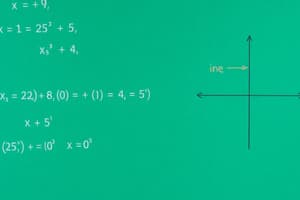Podcast
Questions and Answers
What happens to the inequality sign when you multiply or divide both sides of an inequality by a negative number?
What happens to the inequality sign when you multiply or divide both sides of an inequality by a negative number?
- It becomes positive
- It changes to an equal sign
- It flips (correct)
- It stays the same
An open circle on a number line indicates a value that is included in the solution of an inequality.
An open circle on a number line indicates a value that is included in the solution of an inequality.
False (B)
What is the solution set of the compound inequality x > 3 and x < 7?
What is the solution set of the compound inequality x > 3 and x < 7?
3 < x < 7
The result of the union of the inequalities x < -1 and x > 3 is __________.
The result of the union of the inequalities x < -1 and x > 3 is __________.
Which symbol represents 'not equal to' in inequalities?
Which symbol represents 'not equal to' in inequalities?
The intersection of two inequalities includes all values that satisfy both inequalities.
The intersection of two inequalities includes all values that satisfy both inequalities.
What graphical representation indicates a value that is part of the solution set in an inequality?
What graphical representation indicates a value that is part of the solution set in an inequality?
In a compound inequality connected by 'or', the solution represents the __________ of the solution sets.
In a compound inequality connected by 'or', the solution represents the __________ of the solution sets.
Match the inequality type with its characteristic:
Match the inequality type with its characteristic:
Provide an example of an inequality that would require an open circle when graphed.
Provide an example of an inequality that would require an open circle when graphed.
What represents a set of all points that satisfy two or more linear inequalities?
What represents a set of all points that satisfy two or more linear inequalities?
The solution region of a system of linear inequalities is always bounded.
The solution region of a system of linear inequalities is always bounded.
What notation is used to represent intervals concisely?
What notation is used to represent intervals concisely?
The absolute value inequality |x| < a can be rewritten as _____ < x < _____.
The absolute value inequality |x| < a can be rewritten as _____ < x < _____.
Match the following inequality types with their corresponding explanations:
Match the following inequality types with their corresponding explanations:
Which symbol represents a closed interval in interval notation?
Which symbol represents a closed interval in interval notation?
The overlapping solution region of a system of linear inequalities can never be a polygon.
The overlapping solution region of a system of linear inequalities can never be a polygon.
What method involves solving one equation for a variable and substituting it into another equation?
What method involves solving one equation for a variable and substituting it into another equation?
In the inequality 2 < x < 5, the interval notation would be represented as _____.
In the inequality 2 < x < 5, the interval notation would be represented as _____.
What do you call the area that represents all solutions of a system of linear inequalities?
What do you call the area that represents all solutions of a system of linear inequalities?
Flashcards
Inequality
Inequality
A relationship between two expressions that are not necessarily equal, using symbols like >, <, ≥, ≤, or ≠.
Solving Inequalities
Solving Inequalities
The process of manipulating an inequality to isolate the variable, following similar steps to solving equations, with a crucial difference: when multiplying or dividing by a negative, the inequality sign flips.
Graphing Inequalities
Graphing Inequalities
Representing the solution set of an inequality on a number line, where open circles (o) denote values not included, closed circles (●) represent values included, and the shaded region shows the range satisfying the inequality.
Compound Inequalities
Compound Inequalities
Signup and view all the flashcards
Constraints
Constraints
Signup and view all the flashcards
Intersection of Inequalities
Intersection of Inequalities
Signup and view all the flashcards
Union of Inequalities
Union of Inequalities
Signup and view all the flashcards
System of Linear Inequalities
System of Linear Inequalities
Signup and view all the flashcards
Solving Compound Inequalities
Solving Compound Inequalities
Signup and view all the flashcards
Solution to a System of Inequalities
Solution to a System of Inequalities
Signup and view all the flashcards
Graphing Compound Inequalities
Graphing Compound Inequalities
Signup and view all the flashcards
Solving an Inequality
Solving an Inequality
Signup and view all the flashcards
Graphical Solution
Graphical Solution
Signup and view all the flashcards
Graphing a Compound Inequality Solution
Graphing a Compound Inequality Solution
Signup and view all the flashcards
Algebraic Solution
Algebraic Solution
Signup and view all the flashcards
Absolute Value Inequalities
Absolute Value Inequalities
Signup and view all the flashcards
Solving Absolute Value Inequalities
Solving Absolute Value Inequalities
Signup and view all the flashcards
Interval Notation
Interval Notation
Signup and view all the flashcards
Interval Notation (Use)
Interval Notation (Use)
Signup and view all the flashcards
Study Notes
Solving Inequalities
- Inequalities represent a relationship between two expressions that are not necessarily equal. Symbols used include: > (greater than), < (less than), ≥ (greater than or equal to), ≤ (less than or equal to), ≠ (not equal to).
- Solving inequalities follows similar steps to solving equations, but with a crucial difference: when multiplying or dividing both sides by a negative number, the inequality sign flips.
- For example, if -2x > 4, dividing both sides by -2 gives x < -2.
Graphing Inequalities on a Number Line
- Inequalities can be visualized on a number line.
- A solution set of an inequality is the set of all numbers that make the inequality true.
- An open circle (o) represents a value not included in the solution, while a closed circle (•) represents a value included in the solution.
- Graphing inequalities on a number line shows the range of values where the inequality holds true.
Compound Inequalities
- Compound inequalities combine two or more inequalities.
- They are joined by the words "and" or "or".
- "And" inequalities are satisfied only when all the conditions within the compound inequality are true. The solution represents the intersection of the solution sets of the individual inequalities.
- "Or" inequalities are satisfied when at least one of the conditions is true. The solution represents the union of the solution sets of the individual inequalities.
Intersection of Inequalities
- The intersection of two inequalities involves finding all values that satisfy both inequalities simultaneously.
- This corresponds to the region where the solution sets of the individual inequalities overlap.
- Graphically, it's the portion of the number line that is shaded in both graphs of the individual inequalities.
- Example: To find the intersection of x > 2 and x < 5, you are looking for the region where x is larger than 2 and smaller than 5, resulting in the solution set 2 < x < 5.
Union of Inequalities
- The union of two inequalities involves finding all values that satisfy at least one of the inequalities.
- This corresponds to the entire region shaded in the graphs of either inequality.
- Graphically, it's everything that is shaded in either graph.
- Example: To find the union of x < -1 and x > 3, it consists of any value less than -1 or greater than 3.
Applications of Inequalities
- Inequalities are essential in many real-world scenarios.
- For example, they can be used to express budget constraints, performance targets, or problem limits.
- They provide a way to quantify and express possible boundaries for variables in various contexts.
- Real-world problems involving constraints or conditions often translate naturally into inequalities.
Systems of Linear Inequalities
- A system of linear inequalities consists of two or more linear inequalities that have to be solved simultaneously.
- The solution to a system of linear inequalities is the set of all points that satisfy all of the given inequalities.
- Graphically, the solution is the region where all the shaded regions (corresponding to the solutions of the individual inequalities) overlap.
- This region will often form a polygonal shape or a unbounded region (in which case there would be an infinite number of solution points).
Solving Systems Graphically
- Graph each individual inequality in the system.
- Determine the overlapping solution region on the graph. This is the solution to the entire system.
- The coordinates of any point within the overlapping area are part of the solution set.
Solving Systems Algebraically (where possible)
- This approach is typically suitable for systems with two variables.
- The algebraic method involves solving one equation for a variable in terms of the other variable, then substituting this expression into the other equation.
Absolute Value Inequalities
- Absolute value inequalities are frequently solved by breaking them into two separate inequalities.
- For example, |x| < a is equivalent to -a < x < a, and |x| > a is equivalent to either x > a or x < -a.
- These methods are used strategically to simplify solving absolute value inequalities.
Interval Notation
- A shorthand way of representing an inequality is using interval notation.
- Specific symbols are used to denote open intervals ( ) or closed intervals [ ].
- For example, the interval (2,5) represents the inequality 2 < x < 5 and the interval [2,5] represents the inequality 2 ≤ x ≤ 5.
- This notation is commonly used in mathematics to concisely display solution sets.
Studying That Suits You
Use AI to generate personalized quizzes and flashcards to suit your learning preferences.



